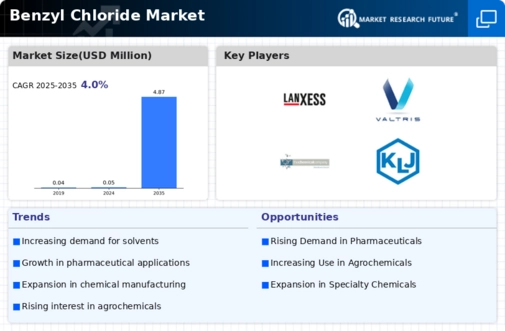Market Trends and Projections
The Global Benzyl Chloride Market Industry is characterized by dynamic trends and projections that highlight its growth trajectory. The market is anticipated to expand significantly, with a forecasted value of 0.05 billion USD in 2024 and a remarkable increase to 4.87 billion USD by 2035. This growth is underpinned by a compound annual growth rate (CAGR) of 51.24% from 2025 to 2035, suggesting a robust future for the industry. These projections reflect the increasing demand across various sectors, including pharmaceuticals, agrochemicals, and industrial applications, indicating a promising outlook for stakeholders in the Global Benzyl Chloride Market Industry.
Increasing Industrial Applications
The Global Benzyl Chloride Market Industry is experiencing growth driven by its diverse industrial applications, including its use in the production of plastics, resins, and dyes. As industries seek versatile chemical solutions, benzyl chloride's adaptability positions it as a valuable component in various manufacturing processes. The ongoing industrialization in emerging economies further amplifies this trend, as demand for materials and chemicals rises. Consequently, the Global Benzyl Chloride Market Industry is expected to capitalize on these developments, reflecting a broader shift towards increased industrial activity and innovation.
Growing Demand in Chemical Synthesis
The Global Benzyl Chloride Market Industry experiences a notable surge in demand due to its pivotal role in chemical synthesis. Benzyl chloride serves as a key intermediate in the production of various chemicals, including benzyl alcohol and benzyl amine, which are essential in pharmaceuticals and agrochemicals. As industries increasingly focus on developing innovative chemical products, the demand for benzyl chloride is projected to rise significantly. This trend is underscored by the anticipated market growth, with a forecasted value of 0.05 billion USD in 2024, indicating a robust trajectory for the Global Benzyl Chloride Market Industry.
Expansion in Pharmaceutical Applications
The Global Benzyl Chloride Market Industry is likely to benefit from the expanding pharmaceutical sector, where benzyl chloride is utilized as a precursor for numerous active pharmaceutical ingredients. The increasing focus on drug development and the rising prevalence of chronic diseases drive the need for effective pharmaceutical compounds. As a result, benzyl chloride's role in synthesizing these compounds becomes increasingly critical. This growth is expected to contribute to a compound annual growth rate (CAGR) of 51.24% from 2025 to 2035, reflecting the dynamic nature of the Global Benzyl Chloride Market Industry as it adapts to the evolving healthcare landscape.
Rising Demand in Agrochemical Production
The Global Benzyl Chloride Market Industry is significantly influenced by the growing demand for agrochemicals, where benzyl chloride is employed in the synthesis of herbicides and insecticides. As agricultural practices evolve and the need for effective pest control solutions increases, the utilization of benzyl chloride in agrochemical formulations is expected to rise. This trend aligns with the broader global emphasis on sustainable agriculture and food security. The market is projected to reach 4.87 billion USD by 2035, indicating a strong correlation between agricultural advancements and the Global Benzyl Chloride Market Industry.
Technological Advancements in Production Processes
Technological innovations in the production of benzyl chloride are poised to enhance efficiency and reduce costs within the Global Benzyl Chloride Market Industry. Advances in chemical engineering and process optimization may lead to more sustainable production methods, thereby attracting investments and fostering growth. These improvements could also facilitate compliance with stringent environmental regulations, which are increasingly shaping the chemical manufacturing landscape. As production processes evolve, the Global Benzyl Chloride Market Industry is likely to witness a shift towards greener practices, aligning with global sustainability goals.















Leave a Comment